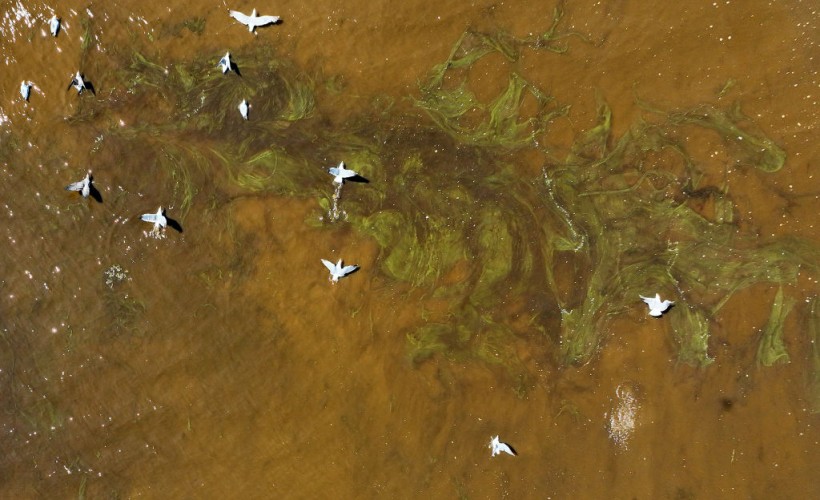Indian Creek Reservoir, found 30 miles southwest of Lake Tahoe, is one location where the so-called "harmful algal blooms," or HABs, have been confirmed.
Toxic algae, as specified in a Newsweek report, that causes people to turn ill, have been found in popular fishing and swimming spots all over California.
Dangerous Algal Blooms Crop up Across California Killing Thousands of Fishhttps://t.co/BmA7qgZP3Z
— She/He (@sirimahanthesh) September 5, 2022
A red tide HAB in San Francisco Bay has also been spotted by the California Water Quality Monitoring Council, which also detected "dangerous" levels of algal toxins in Clear Lake, Lake Crowley, and Bridgeport reservoir.
ALSO READ: Algae Learned To Eat Other Organisms, Surviving the Event That Killed the Dinosaurs

In an aerial view, birds fly over brownish water from an algal bloom in the San Francisco Bay on August 24, 2022, in Berkeley, California. Sections of the San Francisco Bay are being turned brown by a potentially harmful algal bloom.
Impacts of Algal Blooms on Health
Algal blossoms are caused by the rapid growth of a population of algae, also called cyanobacteria, dinoflagellates, or diatoms, that live in a body of water frequently caused by the increased nutrients in the water or rising temperatures.
Such algae can be hazardous if ingested but produce toxins that may intoxicate people and animals exposed to them.
These algae can be harmful if ingested but also produce toxins that may poison people and animals exposed to them.
According to the Centers for Disease Control and Prevention, such toxins may be absorbed through the skin, breathed in, or eaten through contaminated foods.
If exposed to HABs, humans may experience skin irritation, flu-like symptoms, abnormal breathing, and gastrointestinal symptoms. In pets, exposure may result in seizures and, eventually, death.
Marine Plants Dying Due to Lack of Photosynthesis
Essentially, eating shellfish can lead to a condition called Paralytic Shellfish Poisoning or PSP, which, as described by ScienceDirect, is caused by shellfish building up neurotoxins generated by algae they have consumed, leading to paralysis in humans who, in turn, are eating the shellfish.
Beyond poisoning humans and pets, algal blooms can have catastrophic impacts, too, on aquatic ecosystems. Such mass growths quickly use all the oxygen in the water, starving of oxygen and other marine life, as well as generating hazardous gasses and toxins that may kill other organisms.
If the algae clumps turn very dense, they could block out the sunlight and the water column underneath, causing marine plants to die due to a lack of photosynthesis.
Red Tide Algal Bloom in San Francisco Bay
The red tide algal bloom is presently occurring in San Francisco Bay; the most massive of its kind for over a decade has been killing thousands of fish, causing them to wash up on the shore.
As recently reported in Science Times, the California Department of Fish and Wildlife at Lake Merritt in Oakland, connected to San Francisco Bay, said that as many as 10,000 fish died late last month.
The bloom in the Bay Area is believed to have resulted from a sewage influx, providing the algae with additional nutrients that have caused it to increase.
It is anticipated for the algal blooms to worsen with climate change, both in saltwater and freshwater environments.
The CDC's Advice
The CDC has advised avoidance of foul-smelling, looking discolored water. The health agency also advised avoiding water that has scum or foam on the surface or if it has dead fish or other animals on its beach or shore. Eating shellfish from water under the conditions above should also be avoided.
Lastly, the CDC said Hikers should be aware, too, that water filters and boiling may eliminate the algae itself from water. However, it will not eliminate toxins; thus, the water may still be harmful.
A related report about the algae blooms is shown on CBS Los Angeles's YouTube video below:
RELATED ARTICLE: Melting Snow Caps in the Himalayas Cause Toxic Glowing Green Algae to Bloom Big Enough to be Seen From Space
Check out more news and information on Algae in Science Times.














